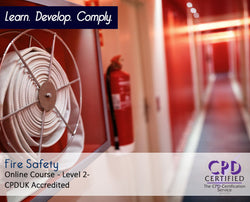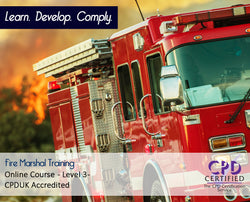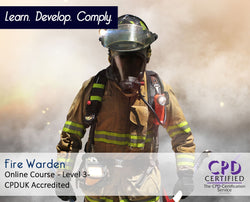You have no items in your shopping basket.
You have no items in your shopping basket.
Fire Safety eLearning Courses & Training - ComplyPlus LMS™ - The Mandatory Training Group UK -
Abstract
Discover the essence of fire safety in our comprehensive blog article. Delve into the critical importance of workplace compliance, expert guidance on navigating regulations, and essential training to mitigate risks. From Fire Risk Assessment to Emergency Evacuation procedures, unlock the key elements of ensuring workplace safety. Explore accredited courses, best practices, and management solutions tailored for businesses. Empower your workforce with essential fire safety awareness and certification training. Join us as we navigate the complexities of fire safety regulations, elevate workplace safety standards, and transform your organisation's approach to fire safety. #FireSafety

Explore our comprehensive range of online fire safety courses on ComplyPlus LMS™ today
Aims
- To raise awareness about the critical importance of fire safety in workplaces and communities.
- To provide comprehensive information and guidance on navigating fire safety regulations and best practices.
- To empower readers with essential knowledge and skills to enhance workplace fire safety and mitigate risks effectively. #WorkplaceSafety
Objectives
- Research and gather relevant information on fire safety regulations, best practices, and training methods.
- Organise and structure the information into a coherent blog format, highlighting key areas of fire safety.
- Incorporate engaging language and visuals to captivate readers and facilitate understanding.
- Provide actionable recommendations and resources for further learning and implementation. #FirePrevention
Learn fire safety best practices with our eLearning courses on ComplyPlus LMS™
Learning Outcomes
- Readers will understand the significance of fire safety in workplace and community settings.
- Readers will be able to identify common fire hazards and implement preventive measures.
- Readers will gain knowledge of fire safety regulations and compliance requirements.
- Readers will acquire skills to conduct Fire Risk Assessments and develop effective emergency evacuation procedures.
- Readers will be equipped with resources and guidance to enhance fire safety practices in their organisations or communities. Ensure Workplace Safety: Essential fire safety. #Compliance Training
Ensuring fire safety: Protecting lives and property in the UK
fire safety is a critical aspect of workplace and community safety, yet its importance is often overlooked until tragedy strikes. In the UK, effective fire safety measures are not just a legal requirement but a moral obligation to protect lives and property. This blog explores the significance of fire safety, highlighting key facts, legislation, regulations, and best practices to empower businesses and individuals to prioritise fire safety. #SafetyFirst
Enhance workplace fire safety awareness with our online courses on ComplyPlus LMS™
Key facts and statistics
- According to the Home Office, fire and rescue services attended approximately 162,000 fire incidents in the UK between 2020 and 2021.
- Fires can have devastating consequences, leading to injuries, fatalities, and significant property damage.
- The economic cost of fire incidents in the UK is estimated to be billions of pounds annually, including direct property damage, business interruption, and healthcare expenses. #FireRiskAssessment
Master Fire Risk Assessment with our interactive online training on ComplyPlus LMS™
Key definitions
- fire safety - Measures and practices aimed at preventing, detecting, and mitigating the risk of fires to protect lives, property, and the environment.
- Fire risk assessment - A systematic evaluation of premises to identify fire hazards, assess the risk of fire occurring, and determine control measures to mitigate risks. #FireWarden
Equip yourself with Fire Warden and Marshal training on ComplyPlus LMS™
Relevant legislation, regulations, and best practices
- Regulatory Reform (fire safety) Order 2005 - This order mandates responsibilities for ensuring fire safety in non-domestic premises in the UK.
- Health and Safety at Work Act 1974 - This Act imposes a duty on employers to ensure the health, safety, and welfare of employees, including fire safety.
- British Standards Institution (BSI) standards such as BS 9999 (fire safety in the Design, Management, and Use of Buildings) and BS 5839 (Fire Detection and Fire Alarm Systems) provide guidance on fire safety best practices. #FireMarshal
Become a fire safety expert with our online train the trainer courses on ComplyPlus LMS™
Elevate your safety standards: Accredited fire safety courses on ComplyPlus LMS™
Understanding fire risks
- Identify common fire hazards in the workplace, such as electrical faults, improper storage of flammable materials, and faulty equipment.
- Conduct regular Fire Risk Assessments to evaluate potential risks and implement appropriate control measures. #ComplianceTraining
Become a fire safety expert with our online train the trainer courses on ComplyPlus LMS™
Implementing fire safety measures
- Install and maintain fire detection and alarm systems to provide early warning of fire incidents.
- Ensure adequate provision of firefighting equipment such as fire extinguishers, fire blankets, and hose reels.
- Develop and communicate clear fire safety policies and procedures, including evacuation plans and emergency response protocols. #SafetyTraining
Ensure workplace safety with our Fire detection systems training on ComplyPlus LMS™
Educating and training personnel
- Provide fire safety training to employees to raise awareness of fire hazards, prevention measures, and emergency procedures.
- Designate and train fire wardens/fire marshals to assist with evacuation and coordinate emergency response efforts. #EmergencyEvacuation
Empower your team with Fire extinguisher training on ComplyPlus LMS
Compliance with legislation and standards
- Stay informed about the latest fire safety legislation, regulations, and standards to ensure compliance and best practices.
- Regularly review and update fire safety policies and procedures to reflect legislation and industry guidelines changes. #HSE
Recommendations
- Prioritise fire safety as a core component of your organisation's health and safety management system.
- Invest in accredited fire safety training courses for employees to enhance awareness and preparedness.
- Conduct regular fire risk assessments and inspections to promptly identify and address potential hazards. #RegulatoryReform
Comply with the Regulatory Reform (fire safety) Order 2005 through our online training on ComplyPlus LMS
Conclusion - essential training for workplace compliance
Effective fire safety is not just about meeting legal requirements but protecting lives, livelihoods, and communities. By implementing robust fire safety measures, businesses and individuals can mitigate risks, prevent tragedies, and create safer environments for all. Let's work together to ensure fire safety remains a top priority in the UK.
Take proactive steps to enhance fire safety in your workplace or community today. Explore our accredited fire safety training courses on ComplyPlus LMS™ and equip yourself and your team with the knowledge and skills to effectively prevent and respond to fire incidents. Together, let's make fire safety a shared commitment for a safer future. #AccreditedTraining
Comply with the Regulatory Reform (fire safety) Order 2005 through our online training on ComplyPlus LMS™
Fire safety overview
fire safety in the UK is governed by stringent regulations and guidelines to prevent and manage fire incidents. Key aspects include risk assessment, fire prevention measures such as adequate building design and maintenance, fire detection and suppression system installation, and staff training. Legislation like the Regulatory Reform (fire safety) Order 2005 mandates responsibilities for building owners and employers to ensure premises meet safety standards. Authorities like the Fire and Rescue Services monitor compliance. Effective fire safety practices save lives, protect property, and maintain a safe working and living environment. #SafetyStandards
Access accredited fire safety courses for businesses on ComplyPlus LMS™
Key definitions
fire safety refers to the measures and practices designed to prevent, detect, and mitigate the risk of fires and protect life, property, and the environment in the event of a fire.
Other key terms related to fire safety include:
- Fire risk assessment - A systematic evaluation of premises and activities to identify fire hazards, assess the risk of fire occurring, and determine the adequacy of existing fire safety measures.
- Fire prevention - Strategies and measures implemented to minimise the likelihood of fire ignition, including proper housekeeping, storage of flammable materials, and maintenance of electrical systems.
- Fire detection - Systems and devices used to detect the presence of fire or smoke, such as smoke detectors, heat detectors, and flame detectors.
- Fire suppression - Techniques and equipment employed to extinguish or control fires, such as fire extinguishers, sprinkler systems, and fire blankets.
- Emergency evacuation - Procedures and protocols for safely evacuating occupants from a building during a fire or other emergency, including evacuation routes, assembly points, and training.
- fire safety legislation - Laws and regulations governing fire safety standards, responsibilities, and enforcement, such as the Regulatory Reform (fire safety) Order 2005 in the UK. #OnlineLearning
Access accredited fire safety courses for businesses on ComplyPlus LMS™
Legislation, regulations and expert guidance
The primary legislation for fire safety in the UK is the Regulatory Reform (fire safety) Order 2005, which outlines duties for ensuring fire safety in non-domestic premises. This is supported by various regulations and expert guidance, including Approved Document B (fire safety) of the Building Regulations, guidance from the National Fire Chiefs Council (NFCC), and standards from the British Standards Institution (BSI) such as BS 9999 and BS 5839. #SafetyManagement
Access accredited fire safety courses for businesses on ComplyPlus LMS™
Regulatory and professional bodies
Key regulatory bodies overseeing fire safety in the UK include the Fire and Rescue Services, which enforces fire safety regulations locally, and the Health and Safety Executive (HSE), responsible for enforcing fire safety in workplaces. Professional bodies such as the Institution of Fire Engineers (IFE) and the Fire Industry Association (FIA) provide guidance, training, and accreditation for fire safety management and engineering professionals. #FireSafetyAwareness
Access accredited fire safety courses for businesses on ComplyPlus LMS™
Relevant national occupational standards
The UK's relevant national occupational standards for fire safety include those developed by Skills for Justice (SFJ), now part of People 1st International. These standards cover areas such as fire safety risk assessment, inspection, and management. Additionally, the Institution of Fire Engineers (IFE) offers professional qualifications and certifications aligned with international standards, further recognising competency in fire safety practice and management. #BusinessSafety
Optimise fire safety management in your organisation with our online courses on ComplyPlus LMS™
Regulatory expectations from providers
CQC key questions and fundamental standards
The Care Quality Commission (CQC) assesses fire safety within healthcare and social care settings using key questions and fundamental standards. Relevant key questions include "Is the service safe?" and "How does the service manage risks to patients and staff?" Fundamental fire safety standards encompass premises management, fire risk assessment, fire prevention measures, staff training, and emergency evacuation procedures, ensuring compliance with fire safety regulations and promoting a safe environment for service users and staff. #BusinessSafety
Optimise fire safety management in your organisation with our online courses on ComplyPlus LMS™
Ofsted framework
Ofsted expects providers, particularly those in the education and childcare sectors, to adhere to stringent fire safety measures outlined in their framework. This includes compliance with relevant legislation such as the Regulatory Reform (Fire Safety) Order 2005 and ensuring premises are equipped with appropriate fire detection and suppression systems. Providers are also expected to conduct regular fire drills, maintain clear evacuation procedures, and provide staff training to ensure the safety of children, students, and staff in the event of a fire. #EmployeeTraining
Consult our fire safety experts with our consultancy services on ComplyPlus LMS™
Health and Safety Executive Guidance
The Health and Safety Executive (HSE) expects organisations to prioritise fire safety as part of their overall health and safety management systems. This includes conducting thorough fire risk assessments to identify hazards and implement appropriate control measures. Organisations are expected to provide adequate training to employees on fire safety procedures, ensure proper fire detection and suppression systems maintenance, and regularly review and update their fire safety policies to comply with regulatory requirements and industry best practices. #EmployeeTraining
Empower your employees with fire safety training on ComplyPlus LMS™
Why are fire safety training courses important?
fire safety training courses are crucial for several reasons:
- Prevention - They educate individuals on identifying fire hazards and implementing preventive measures to reduce the risk of fire incidents.
- Preparedness - Training equips people with the knowledge and skills to respond effectively in the event of a fire, including proper evacuation procedures and how to use fire extinguishers.
- Safety - Understanding fire safety principles enhances personal safety and reduces the likelihood of injuries or fatalities in the event of a fire.
- Compliance - Many regulatory bodies require organisations to provide fire safety training to employees to ensure legal compliance and maintain a safe working environment.
- Property protection - Properly trained individuals can help minimise property damage by taking swift and appropriate action during a fire emergency.
Overall, fire safety training courses are vital in promoting a culture of safety, preparedness, and compliance in both residential and commercial settings. #SafetyConsultancy
Empower your employees with fire safety training on ComplyPlus LMS™
Fire safety training courses on ComplyPlus LMS™
The Mandatory Training Group is a leading UK provider of accredited fire safety courses and training available on ComplyPlus LMS™:
- Fire safety Awareness
- Fire Warden/Fire Marshal Training
- Fire Risk Assessment
- Fire Extinguisher Training
- Evacuation Procedures
- Fire Safety in Healthcare Settings
- Fire Safety in Schools and Educational Facilities
- Fire Safety in the Workplace
- Fire Safety for Construction Sites
- Fire Safety for Hotels and Hospitality Industry
- fire safety for Retail and Commercial Premises
- Fire Safety for Care Homes
- Fire Safety Legislation and Regulations
- Fire Safety Management
- FIre Safety for High-Rise Buildings
- Fire Safety for Historic Buildings
- Electrical fire safety
- Kitchen fire safety
- Fire Safety for Events and Venues
- Fire Safety for Transport and Vehicles
- Fire Safety for Laboratories
- Fire Safety for Warehouses
- Fire Safety for Industrial Settings
- Passive Fire Protection
- Fire Safety for Social Housing
- Fire Safety for Leisure and Sports Facilities
- Fire Safety for Offices
- Fire Safety for Retail Stores
- Fire Safety for Restaurants and Food Establishments
- Fire Safety for Small Businesses
These are general topics, and the specific courses may vary depending on the provider and their focus areas. You can contact The Mandatory Training Group directly for information on the courses available on ComplyPlus LMS™ related to fire safety. #LMS
Empower your employees with fire safety training on ComplyPlus LMS™
Professional body recommendations and published best practice guidance
Professional recommendations and published best practice guidance relevant to fire safety training courses include those from professional bodies such as the Institution of Fire Engineers (IFE), the Fire Industry Association (FIA), and the National Fire Protection Association (NFPA). Additionally, standards and guidance from organisations like the British Standards Institution (BSI) and the Health and Safety Executive (HSE) are essential. Peer-reviewed literature, such as journals like Fire Technology and Fire Safety Journal provide valuable insights into emerging trends, research findings, and best practices in fire safety management, risk assessment, and mitigation strategies. #LMS
Take control of fire safety training with our online courses on ComplyPlus LMS™
Guidance for managers and leaders
Effective fire safety is paramount for leaders and managers as it ensures the safety and well-being of employees, customers, and the public while also safeguarding assets and reputation. Leaders must understand that prioritising fire safety reduces the risk of injuries and fatalities and mitigates financial losses and legal liabilities associated with fire incidents. To implement effective fire safety policies and procedures:
- Conduct comprehensive risk assessments regularly to identify potential fire hazards and evaluate existing control measures.
- Develop and communicate clear fire safety policies and procedures to all staff, ensuring they understand their roles and responsibilities in fire prevention, evacuation, and emergency response.
- Provide regular fire safety training to employees, including fire awareness, evacuation drills, and use of firefighting equipment.
- Ensure adequate provision and maintenance of fire detection and suppression systems, emergency lighting, and escape routes.
- Stay informed about the latest legislation, regulations, and best practice recommendations from regulatory bodies and professional associations, such as the Health and Safety Executive (HSE) and the Institution of Fire Engineers (IFE), and update policies and procedures accordingly.
By fostering a culture of fire safety awareness and compliance, leaders demonstrate their commitment to protecting people and property, thereby creating a safer and more resilient workplace. #WorkplaceHealth
Take control of fire safety training with our online courses on ComplyPlus LMS™
fire safety policies and procedures
Managers and leaders should draft comprehensive fire safety policies and procedures that align with relevant UK legislation, such as the Regulatory Reform (Fire Safety) Order 2005 and associated guidance from the Health and Safety Executive (HSE). International standards such as NFPA 101 (Life Safety Code) and ISO 45001 also provide valuable frameworks for enhancing fire safety practices. Policies should outline responsibilities for fire risk assessment, prevention measures, emergency evacuation procedures, and staff training requirements. Regular reviews and updates are essential to ensure compliance with evolving regulations and best practices, fostering a culture of safety and resilience within the organisation.
Frequently asked questions about fire safety
Here are 25 frequently asked questions (FAQs) about fire safety, along with their answers:
What is fire safety?
Fire safety refers to measures and practices aimed at preventing, detecting, and mitigating the risk of fires, ensuring the safety of people and property.
What legislation governs fire safety in the UK?
The primary legislation is the Regulatory Reform (Fire Safety) Order 2005, which outlines responsibilities for ensuring fire safety in non-domestic premises.
What role does the Health and Safety Executive (HSE) play in fire safety?
The HSE provides guidance and enforces workplace fire safety regulations to ensure compliance and promote a safe working environment.
How often should fire risk assessments be conducted?
Fire risk assessments should be conducted regularly and reviewed annually or whenever significant changes occur in the premises or operations.
What is the significance of fire safety training?
Fire safety training is crucial for educating individuals on identifying fire hazards, implementing preventive measures, and responding effectively in case of a fire emergency.
How does ComplyPlus LMS™ support fire safety training?
ComplyPlus LMS™ offers a platform for delivering accredited fire safety courses, ensuring easy access to training materials and tracking employee compliance.
What are the key elements of a fire safety policy?
A fire safety policy should include procedures for fire risk assessment, prevention, evacuation, staff training, maintenance of fire detection systems, and emergency response.
What is the role of fire wardens/fire marshals?
Fire wardens/fire marshals play a vital role in implementing fire safety procedures, assisting with evacuation, and coordinating emergency responses during a fire incident.
How can businesses ensure compliance with fire safety regulations?
Businesses can ensure compliance by staying updated on relevant legislation, conducting regular risk assessments, providing training, and implementing recommended control measures.
What are the common fire hazards in the workplace?
Faulty electrical equipment, improper storage of flammable materials, inadequate housekeeping, and smoking in prohibited areas are common fire hazards.
How can businesses prevent fires in the workplace?
Fire prevention measures include proper storage of flammable materials, regular maintenance of electrical systems, enforcing no-smoking policies, and implementing fire safety training for employees.
What should employees do in case of a fire?
In case of a fire, employees should evacuate the premises following designated escape routes, alert others, and avoid using elevators. They should also report the fire to emergency services and follow instructions from fire wardens.
What is the importance of emergency evacuation drills?
Emergency evacuation drills help familiarise occupants with evacuation procedures, identify potential obstacles, and ensure a swift and orderly evacuation in case of a real fire emergency.
How often should fire extinguishers be inspected?
Fire extinguishers should be inspected regularly, typically monthly, by designated personnel to ensure they are in good working condition and ready for use in case of a fire.
What are the types of fire extinguishers and their uses
Common types of fire extinguishers include water, foam, CO2, and dry powder extinguishers, each designed for specific types of fires such as Class A, B, C, or electrical fires.
How can businesses ensure the effectiveness of their fire detection systems?
Businesses should regularly test and maintain fire detection systems, including smoke alarms, heat detectors, and fire alarms, to ensure they are operational and can promptly alert occupants in case of a fire.
What is the role of fire doors in fire safety?
Fire doors help contain the spread of fire and smoke, providing occupants with additional time to evacuate safely. To maintain their effectiveness, they should be kept closed at all times, except when in use.
What are the penalties for non-compliance with fire safety regulations?
Non-compliance with fire safety regulations can result in fines, legal action, or even imprisonment for responsible individuals or organisations. It can also lead to serious consequences such as injuries, fatalities, and property damage in case of a fire incident.
How can businesses ensure fire safety in high-rise buildings?
Fire safety measures in high-rise buildings include adequate fire detection and suppression systems, emergency evacuation procedures, compartmentation to prevent fire spread, and regular fire drills to familiarise occupants with escape routes.
What is the significance of passive fire protection measures?
Passive fire protection measures such as fire-resistant building materials, fire doors, and compartmentation help contain fires, limit their spread, and provide additional time for safe evacuation.
How can businesses ensure fire safety during construction projects?
Construction sites should implement fire safety measures such as fire risk assessments, provision of firefighting equipment, secure storage of flammable materials, and regular site inspections to identify and address hazards.
What fire safety considerations are relevant to healthcare settings?
Fire safety in healthcare settings involves specific considerations such as fire risk assessment for vulnerable patients, evacuation plans for non-ambulatory individuals, and ensuring the continuity of critical services during a fire incident.
How can businesses ensure compliance with international fire safety standards?
Businesses can ensure compliance with international standards such as NFPA 101 (Life Safety Code) and ISO 45001 by aligning their fire safety policies and procedures with the requirements outlined in these standards and seeking accreditation from relevant certifying bodies.
What resources are available for businesses to improve fire safety?
Businesses can access resources such as guidance documents from regulatory bodies like the HSE, professional associations such as the IFE and FIA, and accredited fire safety training courses offered by providers like The Mandatory Training Group on ComplyPlus LMS™.
How can businesses stay updated on the latest fire safety regulations and best practices?
Businesses can stay updated by subscribing to newsletters, attending seminars or webinars, joining professional associations, and regularly reviewing guidance documents and publications from regulatory bodies and industry experts. Additionally, ComplyPlus LMS™ provides access to updated training materials and resources to ensure ongoing compliance with fire safety requirements.
These FAQs provide comprehensive information on fire safety, address common queries, and guide businesses in ensuring compliance and maintaining a safe working environment. #StaySafe
Invest in workplace safety with our fire safety eLearning courses on ComplyPlus LMS™
Why choose ComplyPlus LMS™?
Choose ComplyPlus LMS™ from The Mandatory Training Group UK for your fire safety training needs and benefit from accredited courses delivered on a user-friendly platform. With our comprehensive content, easy accessibility, and robust tracking features, you can ensure compliance and enhance safety standards efficiently. Elevate your fire safety training experience today and prioritise safety in your organisation. Click here to explore our courses now! #AccreditedTraining
Invest in workplace safety with our fire safety eLearning courses on ComplyPlus LMS™
Fire Safety eLearning Courses & Training - ComplyPlus LMS™ - The Mandatory Training Group UK -
-
Fire Safety - Online Training Course - Level 2 - CPDUK Accredited
Fire Safety - Online Training Course - Level 2 - CPDUK Accredited. Welcome to The Mandatory Training Group's online Fire Safety training course for all sectors. This online fire safety training...£19.99 -
Fire Marshal Training - Online Course - CPDUK Accredited with Certificate
.Fire Marshal Training - Online Course - Level 3 - CPDUK Accredited. Welcome to The Mandatory Training Group's online Fire Marshal Training course for all sectors. This online Fire Marshal Training...£24.99 -
Fire Warden - Online Course - Level 3 - CPDUK Accredited
Fire Warden - Online Training Course - Level 3 - CPDUK Accredited. Welcome to The Mandatory Training Group's online Fire Warden training course. Our online Fire Warden training courses are...£24.99
- Accounting/Bookkeeping/Finance
- Basic Life Support/Resuscitation
- Business Administration
- Business Compliance
- Charities & Volunteering
- Clinical Skills
- ComplyPlus™ Software
- Computing & IT
- Conflict Management/Resolution
- Customer Service
- Early Years & Childcare
- Enhanced Dental CPD
- Fire Safety
- First Aid/FAW & EFAW
- Food Hygiene/Food Safety
- Free Online Courses
- Health & Safety
- Health & Social Care
- Leadership & Management
- Long-Term Conditions
- Mandatory Training Bundles
- Mental Health
- Moving & Handling
- Schools & Colleges
- Safeguarding
- Sales & Marketing
- Train the Trainer
- Professional Development
- Price
-
-
Below £10.00
-
£10.00-19.00
-
£20.00-29.00
-
£30.00-39.00
-
£40.00-49.00
-
Above £50.00
-









